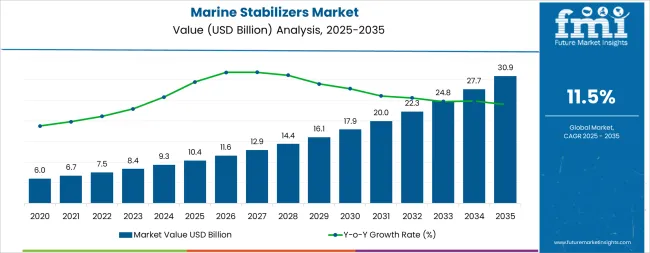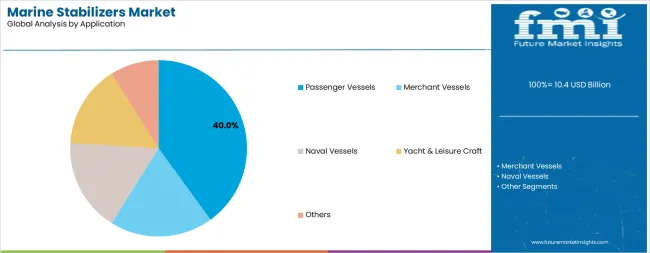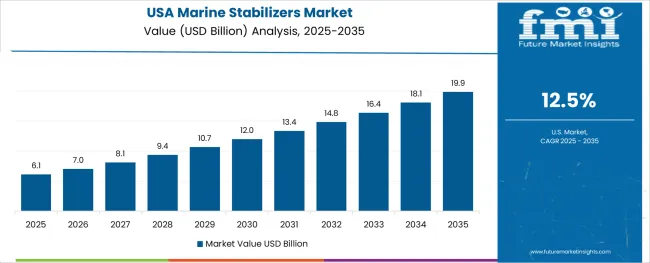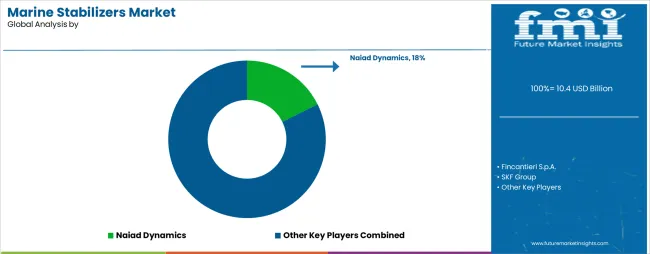The marine stabilizers market is expected to expand from USD 10.4 billion in 2025 to USD 30.9 billion in 2035, at a CAGR of 11.5%. Changes in market distribution will largely depend on technological upgrades, the adoption of advanced stabilization solutions, and growing requirements from luxury and commercial vessels. Providers offering high-performance, low-maintenance stabilizers are well-positioned to increase their market share, while those with older or less efficient systems may experience a decline in their market presence. Growth in cruise ships, leisure yachts, and commercial shipping is likely to create opportunities for innovative companies to strengthen their market position.
Between 2025 and 2030, market share gains may favor manufacturers introducing gyroscopic and active fin stabilizers with improved performance and energy efficiency. These innovations are expected to attract both retrofit and new-build projects, enhancing brand positioning and widening market presence. From 2030 to 2035, additional gains are likely in emerging regions as marine tourism and commercial shipping increase, while companies that fail to innovate or maintain competitive pricing may lose share. Overall, the market shows a net gain for players focusing on technological advancement and global expansion, while traditional providers face gradual erosion, reflecting a dynamic competitive landscape driven by evolving demand and performance expectations.

The marine stabilizers market is primarily divided between Original Equipment Manufacturers (OEMs) and the aftermarket sector. OEMs hold a significant share, accounting for approximately 65% of the market. This dominance is driven by established partnerships with shipbuilders and vessel manufacturers, ensuring a steady demand for stabilizer systems during the production of new vessels. The aftermarket segment, comprising about 35% of the market, caters to vessel owners seeking to retrofit or upgrade their existing ships with advanced stabilization technologies. This sector's growth is fueled by the increasing need for enhanced passenger comfort and safety across various types of vessels, including commercial, recreational, and naval ships.
Recent trends in the marine stabilizers market indicate a shift towards advanced stabilization technologies and increased demand for energy-efficient solutions. Manufacturers are focusing on developing stabilizer systems that offer improved performance while minimizing energy consumption. The integration of smart technologies, such as automated control systems and real-time monitoring, is gaining traction to enhance the efficiency and effectiveness of stabilizers.
| Metric | Value |
|---|---|
| Market Value (2025) | USD 10.4 billion |
| Market Forecast (2035) | USD 30.9 billion |
| Growth Rate | 11.5% CAGR |
| Leading System Type | Retractable Fin Stabilizers |
| Primary Application | Passenger Vessels |
The market demonstrates strong fundamentals with Retractable Fin Stabilizers capturing a dominant share through advanced stabilization features and proven performance capabilities. Passenger Vessels applications drive primary demand, supported by increasing cruise operator spending on comfort enhancement systems and passenger experience technologies. Geographic expansion remains concentrated in developed markets with established maritime industries, while emerging economies show accelerating adoption rates driven by shipbuilding modernization and rising vessel comfort standards.
Market expansion rests on three fundamental shifts driving adoption across the maritime and transportation sectors.
The growth faces headwinds from capital investment challenges that vary across operators regarding the deployment of advanced stabilization systems and retrofit budget protocols, which may limit operational flexibility in certain maritime environments. Technical limitations also persist regarding system weight and power consumption that may reduce system performance with smaller vessels or legacy ship designs that limit stabilization capabilities.
The marine stabilizers market represents a transformative growth opportunity, expanding from USD 10.4 billion in 2025 to USD 30.9 billion by 2035 at an 11.5% CAGR. As maritime operators worldwide prioritize passenger comfort, cargo protection, and operational efficiency, stabilization systems have evolved from luxury equipment to mission-critical infrastructure, enabling superior vessel performance, reducing operational downtime, and supporting excellence across cruise, commercial shipping, and naval applications.
The convergence of maritime safety mandates, increasing passenger experience requirements, stabilization technology maturation, and regulatory acceptance of advanced systems creates unprecedented adoption momentum. Advanced stabilization algorithms offering superior performance, seamless vessel integration, and operational compliance will capture premium market positioning, while geographic expansion into emerging maritime markets and scalable system deployment will drive volume leadership. Government maritime modernization programs and international safety standardization provide structural support.
Leading with 65.0% market share through superior stabilization performance, hydrodynamic efficiency, and operational flexibility, retractable solutions enable comprehensive motion reduction across diverse vessel types without significant hull modifications. Advanced features, including automated fin deployment, real-time sea condition monitoring, and seamless integration with vessel control systems, command premium pricing while improving passenger comfort and cargo safety. Expected revenue pool: USD 19.5-21.5 billion.
Dominating with 40.0% market share, passenger vessel applications drive primary demand through advanced stabilization for cruise ships, ferries, and expedition vessels. Specialized systems for luxury cruise stabilization, high-speed ferry motion control, and expedition ship comfort that exceed passenger satisfaction standards while maintaining operational efficiency capture significant premiums from cruise operators and ferry companies. Opportunity: USD 11.5-13.0 billion.
The United States (12.5% CAGR) leads regional growth through strong cruise industry demand, extensive retrofit programs, and advanced naval vessel requirements. Strategic partnerships enabling compliance with USA Coast Guard regulations, American Bureau of Shipping standards, and cost-effective solutions tailored for domestic market requirements capture expanding demand. Geographic expansion upside: USD 8.5-10.0 billion.
Beyond traditional passenger applications, stabilizer systems in merchant vessels, naval ships, and specialized work boats represent high-growth segments. Advanced stabilization for cargo protection, military vessel operations, and offshore support vessels that improve operational efficiency while ensuring cargo integrity create differentiated value propositions with premium pricing potential. Revenue opportunity: USD 6.0-7.5 billion.
Maritime digitalization drives demand for smart stabilization systems, enabling predictive performance optimization, IoT monitoring, and automated sea state response. Advanced solutions supporting vessel automation, remote diagnostics, and performance analytics expand addressable markets beyond traditional stabilization applications. Technology advancement pool: USD 4.5-6.0 billion.
Growing demand for non-retractable fin stabilizers (35.0% market share) and hybrid stabilization systems combining fins with gyroscopic technology. Cost-effective solutions supporting specialized vessel requirements, reduced maintenance complexity, and multi-technology deployment create new market opportunities with moderate premium potential. Alternative technology opportunity: USD 3.5-5.0 billion.
Increasing retrofit demand for existing vessels seeking modern stabilization capabilities drives aftermarket growth. Upgrade solutions supporting legacy vessel enhancement, performance improvement, and regulatory compliance without extensive shipyard modifications expand addressable markets with service-based revenue streams. Retrofit solutions pool: USD 2.5-4.0 billion.
The market segments by system type into Retractable Fin Stabilizers and Non-Retractable Fin Stabilizers categories, representing the evolution from fixed installation solutions to advanced retractable systems for optimal hydrodynamic performance.
Application segmentation divides the market into Passenger Vessels, Merchant Vessels, Naval Vessels, Yacht & Leisure Craft, and Others sectors, reflecting distinct requirements for cruise operations, commercial shipping, military applications, and luxury maritime segments.
Geographic distribution covers North America, Asia Pacific, Europe, Middle East & Africa, and Latin America, with developed markets leading adoption while emerging economies show accelerating growth patterns driven by shipbuilding and vessel modernization programs.
The segmentation structure reveals technology progression from traditional fixed stabilizers toward integrated retractable platforms with enhanced efficiency and control capabilities, while application diversity spans from passenger comfort to cargo protection solutions requiring precise motion control assistance.

Market Position: Retractable Fin Stabilizers command the leading position in the Marine Stabilizers market with approximately 65.0% market share through advanced stabilization features, including superior hydrodynamic efficiency, reduced drag when retracted, and comprehensive motion control capabilities that enable vessel operators to deploy optimal stabilization across diverse sea conditions without permanent hull protrusions.
Value Drivers: The segment benefits from vessel operator preference for high-performance stabilization systems that provide exceptional roll reduction without compromising vessel speed or fuel efficiency. Retractable system design features enable deployment during rough seas while retracting during calm conditions, optimizing operational efficiency and maintaining streamlined hull profiles.
Competitive Advantages: Retractable systems differentiate through established performance records, proven efficiency capabilities, and integration with existing vessel management systems that enhance operational effectiveness while maintaining cost-effective profiles suitable for operators of all vessel sizes.
Key market characteristics:

Market Context: Passenger Vessels applications dominate the Marine Stabilizers market with approximately 40.0% market share due to widespread adoption of advanced stabilization systems and increasing focus on passenger comfort, cruise experience quality, and operational differentiation that optimize guest satisfaction while maintaining safety effectiveness.
Appeal Factors: Cruise operators prioritize system reliability, stabilization performance, and integration with existing vessel infrastructure that enables coordinated comfort management across multiple deck levels and passenger areas. The segment benefits from substantial cruise industry investments and vessel modernization programs that emphasize comfort enhancement technologies for improved guest experience and operational reputation.
Growth Drivers: Global cruise industry expansion incorporates advanced stabilization systems as standard equipment for new vessel construction and retrofit applications. Simultaneously, increasing passenger expectations are driving demand for stabilization capabilities that maintain comfort standards and minimize motion-related discomfort.
Market Challenges: High retrofit costs and complex integration requirements may limit system deployment in older passenger vessels or budget-constrained ferry operations.
Application dynamics include:
Growth Accelerators: Maritime passenger comfort drives primary adoption as stabilization systems provide motion reduction capabilities that enable superior vessel experience without safety compromises, supporting cruise line differentiation and passenger satisfaction missions that require precise comfort management. The demand for vessel modernization accelerates market expansion as operators seek effective comfort enhancement tools that minimize passenger complaints while maintaining operational effectiveness during various sea conditions and route scenarios. Cruise industry spending increases worldwide, creating sustained demand for advanced stabilization systems that complement traditional vessel equipment and provide competitive advantages in crowded maritime markets.
Growth Inhibitors: Capital investment challenges vary across operators regarding the deployment of advanced stabilization systems and retrofit budget allocation protocols, which may limit adoption flexibility and market penetration in regions with constrained maritime budgets. Technical performance limitations persist regarding system weight, power consumption, and integration complexity that may reduce effectiveness with smaller vessels, older ship designs, or complex propulsion configurations that limit stabilization capabilities. Market fragmentation across multiple vessel types and operational requirements creates compatibility concerns between different stabilizer providers and existing vessel systems.
Market Evolution Patterns: Adoption accelerates in cruise and luxury yacht sectors where passenger comfort justifies premium system costs, with geographic concentration in developed markets transitioning toward mainstream adoption in emerging economies driven by shipbuilding growth and maritime infrastructure development. Technology development focuses on enhanced stabilization efficiency, reduced power consumption, and compatibility with diverse vessel platforms that optimize comfort delivery and operational effectiveness. The market could face disruption if alternative stabilization technologies or economic downturns significantly limit vessel construction and retrofit activities in maritime applications.
The marine stabilizers market demonstrates varied regional dynamics with Growth Leaders including the United States (12.5% CAGR) and Germany (11.8% CAGR) driving expansion through cruise industry strength and advanced maritime technology development. Steady Performers encompass South Korea (11.2% CAGR), Japan (10.6% CAGR), and France (10.1% CAGR), benefiting from established shipbuilding industries and vessel modernization programs. Emerging Markets feature the United Kingdom (9.7% CAGR) and Brazil (9.1% CAGR), where specialized maritime applications and cruise tourism growth support consistent expansion patterns.

| Country | CAGR (2025-2035) |
|---|---|
| United States | 12.5% |
| Germany | 11.8% |
| South Korea | 11.2% |
| Japan | 10.6% |
| France | 10.1% |
| United Kingdom | 9.7% |
| Brazil | 9.1% |
Regional synthesis reveals North American markets leading growth through cruise industry dominance and extensive retrofit demand, while Asian countries maintain strong expansion supported by shipbuilding excellence and vessel technology advancement. European markets show steady growth driven by cruise operations and maritime technology leadership.

The United States establishes market leadership through the world's largest cruise industry and comprehensive vessel modernization programs, integrating advanced stabilization systems as standard components in new cruise ship construction and retrofit applications. The country's 12.5% CAGR through 2035 reflects cruise line investments in passenger comfort enhancement and fleet expansion programs that mandate advanced stabilization in vessel specifications. Growth concentrates in major cruise ports, including Miami, Port Canaveral, and Los Angeles, where maritime technology development showcases integrated stabilizer systems that appeal to cruise operators seeking competitive differentiation and passenger satisfaction applications.
American cruise lines are deploying cutting-edge stabilization solutions that combine superior performance with advanced features, including real-time sea condition monitoring and automated control systems. Distribution channels through marine equipment suppliers and specialized retrofit contractors expand market access, while cruise industry capital investment supports adoption across diverse vessel types and operational segments.

In Hamburg, Bremerhaven, and Kiel, German shipyards and marine technology companies are implementing advanced stabilization systems as standard equipment for cruise vessels, ferries, and specialized maritime applications, driven by engineering excellence and European Union maritime safety initiatives. The market is projected to demonstrate an 11.8% CAGR through 2035, supported by German shipbuilding leadership and marine technology development programs that promote advanced vessel comfort systems for European and international operators. German maritime companies are adopting stabilization systems that provide superior performance and regulatory compliance features, particularly appealing in premium vessel segments where engineering quality represents critical requirements.
Market expansion benefits from established marine technology infrastructure and strong partnerships between equipment manufacturers and shipbuilders that enable integrated system development for advanced maritime applications. Technology adoption follows patterns established in automotive and industrial sectors, where performance optimization and quality standards drive procurement decisions and system specifications.
South Korea's advanced shipbuilding market demonstrates sophisticated stabilizer deployment with documented performance effectiveness in commercial vessels and specialized ship construction through integration with Korean maritime technology and vessel design expertise. The country leverages shipbuilding dominance and marine engineering capabilities to maintain an 11.2% CAGR through 2035. Shipyards including Hyundai, Samsung, and Daewoo showcase advanced installations where stabilization integrates with comprehensive vessel management systems and propulsion platforms to optimize comfort and operational efficiency.
Korean shipbuilders prioritize system reliability and international maritime standards in stabilizer specifications, creating demand for proven systems with advanced features, including performance validation and integration with Classification Society requirements. The market benefits from established maritime industry infrastructure and willingness to adopt innovative stabilization technologies that provide competitive advantages in global shipbuilding markets.

Japan’s marine fin stabilizer market is projected to grow steadily at a CAGR of 10.6% through 2035, fueled by its strong foundation in precision engineering and long-standing maritime traditions. Japanese shipbuilders consistently emphasize high-quality stabilization systems that integrate seamlessly with onboard automation, delivering superior durability and long-term operational reliability. The country’s market reflects a strong orientation toward technological sophistication, with demand centered on precision control algorithms, advanced hydrodynamic modeling, and real-time performance validation.
Growth is supported by premium passenger ships, naval programs, and specialized commercial vessels operating in demanding waters, where stability and comfort are mission-critical. The Japan’s innovation ecosystem fosters continuous R&D into energy-efficient stabilizers that align with both environmental targets and operational cost reduction. As maritime operators increasingly demand systems that combine automation, fuel efficiency, and safety, Japan is set to remain a leader in developing stabilizers that deliver both comfort and strategic operational excellence.
France’s marine fin stabilizer market is forecast to grow at a 10.1% CAGR through 2035, supported by a broad maritime base encompassing cruise, ferry, and naval segments. France benefits from a unique geographic position, with strong Mediterranean cruise activity and extensive English Channel ferry operations, making passenger comfort and safety central to demand. The modernization of ferry fleets and growth in cruise tourism are creating strong incentives for adoption of retractable and active fin stabilizers that reduce motion sickness and improve passenger experience.
The France’s naval shipbuilding heritage, backed by defense programs, is fostering adoption of stabilizers in military vessels to ensure performance in rough seas. French shipyards and marine equipment manufacturers are advancing hybrid stabilization systems, combining efficiency, automation, and reduced drag for optimal performance. By focusing on passenger experience, defense reliability, and sustainability goals, France is consolidating its position as a key European market for advanced stabilizers.
In Southampton, Portsmouth, and Glasgow, British cruise operators and ferry companies are implementing advanced stabilization systems to enhance passenger comfort and support operational excellence that aligns with UK maritime standards and safety regulations. The UK market is expected to demonstrate sustained growth with a 9.7% CAGR through 2035, driven by cruise tourism expansion and ferry fleet modernization programs that emphasize comfort technologies for passenger satisfaction.
Market expansion benefits from maritime industry investments that support advanced stabilization capabilities in vessel specifications, creating sustained demand across passenger vessel sectors where comfort effectiveness and safety compliance represent critical requirements. The regulatory framework supports stabilizer adoption through maritime equipment standards and vessel certification requirements that promote advanced comfort systems aligned with international maritime capabilities.
Brazil's market expansion benefits from offshore industry growth, cruise tourism development along the Brazilian coast, and naval modernization programs that increasingly incorporate stabilization solutions for operational applications. The country maintains a 9.1% CAGR through 2035, driven by maritime industry diversification and increasing awareness of stabilization benefits for passenger comfort and cargo protection.
Market dynamics focus on cost-effective stabilization solutions that balance advanced performance with affordability considerations important to Brazilian vessel operators. Growing shipbuilding activity creates sustained demand for stabilizer systems in new vessel construction and equipment upgrade projects.

The marine stabilizers market operates with moderate concentration, featuring approximately 12-15 meaningful participants, where leading companies control roughly 62-68% of the global market share through established maritime relationships and comprehensive stabilization system portfolios. Competition emphasizes performance reliability, system integration capabilities, and proven operational track records rather than price-based rivalry.
Market Leaders encompass Naiad Dynamics, Fincantieri S.p.A., SKF Group, Quantum Marine Stabilizers, and Kongsberg Maritime, which maintain competitive advantages through extensive maritime technology expertise, global shipbuilder networks, and comprehensive system integration capabilities that create customer switching costs and support premium pricing. These companies leverage decades of marine equipment experience and ongoing research investments to develop advanced stabilization systems with sophisticated control algorithms and performance validation capabilities.
Technology Challengers include companies competing through specialized stabilization focus and innovative control interfaces that appeal to vessel operators seeking advanced performance capabilities and operational flexibility. These companies differentiate through rapid technology development cycles and specialized maritime application focus.
Regional Specialists feature companies focusing on specific geographic markets and specialized applications, including luxury yacht systems and naval vessel platforms. Market dynamics favor participants that combine reliable stabilization algorithms with advanced vessel software, including real-time monitoring and automated control capabilities. Competitive pressure intensifies as traditional marine equipment contractors expand into stabilization systems, while specialized maritime technology companies challenge established players through innovative solutions and cost-effective platforms targeting specialized vessel segments.
| Item | Value |
|---|---|
| Quantitative Units | USD 10.4 billion (2025) |
| System Type | Retractable Fin Stabilizers, Non-Retractable Fin Stabilizers |
| Application | Passenger Vessels, Merchant Vessels, Naval Vessels, Yacht & Leisure Craft, Others |
| Regions Covered | North America, Asia Pacific, Europe, Latin America, Middle East & Africa |
| Countries Covered | United States, Germany, South Korea, Japan, France, United Kingdom, Brazil, and 20+ additional countries |
| Key Companies Profiled | Naiad Dynamics, Fincantieri S.p.A., SKF Group, Quantum Marine Stabilizers, Kongsberg Maritime, and others |
| Additional Attributes | Dollar sales by system type and application categories, regional adoption trends across North America, Asia Pacific, and Europe, competitive landscape with marine equipment providers and stabilization specialists, vessel operator preferences for stabilization efficiency and system reliability, integration with vessel automation systems and navigation platforms, innovations in control algorithms and predictive stabilization, and development of advanced solutions with enhanced performance and monitoring capabilities. |
The global marine stabilizers market is estimated to be valued at USD 10.4 billion in 2025.
The market size for the marine stabilizers market is projected to reach USD 30.9 billion by 2035.
The marine stabilizers market is expected to grow at a 11.5% CAGR between 2025 and 2035.
The key product types in marine stabilizers market are retractable fin stabilizers and non-retractable fin stabilizers.
In terms of application, passenger vessels segment to command 40.0% share in the marine stabilizers market in 2025.






Our Research Products

The "Full Research Suite" delivers actionable market intel, deep dives on markets or technologies, so clients act faster, cut risk, and unlock growth.

The Leaderboard benchmarks and ranks top vendors, classifying them as Established Leaders, Leading Challengers, or Disruptors & Challengers.

Locates where complements amplify value and substitutes erode it, forecasting net impact by horizon

We deliver granular, decision-grade intel: market sizing, 5-year forecasts, pricing, adoption, usage, revenue, and operational KPIs—plus competitor tracking, regulation, and value chains—across 60 countries broadly.

Spot the shifts before they hit your P&L. We track inflection points, adoption curves, pricing moves, and ecosystem plays to show where demand is heading, why it is changing, and what to do next across high-growth markets and disruptive tech

Real-time reads of user behavior. We track shifting priorities, perceptions of today’s and next-gen services, and provider experience, then pace how fast tech moves from trial to adoption, blending buyer, consumer, and channel inputs with social signals (#WhySwitch, #UX).

Partner with our analyst team to build a custom report designed around your business priorities. From analysing market trends to assessing competitors or crafting bespoke datasets, we tailor insights to your needs.
Supplier Intelligence
Discovery & Profiling
Capacity & Footprint
Performance & Risk
Compliance & Governance
Commercial Readiness
Who Supplies Whom
Scorecards & Shortlists
Playbooks & Docs
Category Intelligence
Definition & Scope
Demand & Use Cases
Cost Drivers
Market Structure
Supply Chain Map
Trade & Policy
Operating Norms
Deliverables
Buyer Intelligence
Account Basics
Spend & Scope
Procurement Model
Vendor Requirements
Terms & Policies
Entry Strategy
Pain Points & Triggers
Outputs
Pricing Analysis
Benchmarks
Trends
Should-Cost
Indexation
Landed Cost
Commercial Terms
Deliverables
Brand Analysis
Positioning & Value Prop
Share & Presence
Customer Evidence
Go-to-Market
Digital & Reputation
Compliance & Trust
KPIs & Gaps
Outputs
Full Research Suite comprises of:
Market outlook & trends analysis
Interviews & case studies
Strategic recommendations
Vendor profiles & capabilities analysis
5-year forecasts
8 regions and 60+ country-level data splits
Market segment data splits
12 months of continuous data updates
DELIVERED AS:
PDF EXCEL ONLINE
Marine Nanocoating Market Size and Share Forecast Outlook 2025 to 2035
Marine-grade Polyurethane Market Size and Share Forecast Outlook 2025 to 2035
Marine Electronics Market Size and Share Forecast Outlook 2025 to 2035
Marine Toxin Market Size and Share Forecast and Outlook 2025 to 2035
Marine Thermal Fluid Heaters Market Size and Share Forecast Outlook 2025 to 2035
Marine Nutraceutical Market Size and Share Forecast Outlook 2025 to 2035
Marine Power Battery System Market Size and Share Forecast Outlook 2025 to 2035
Marine Life Raft Market Size and Share Forecast Outlook 2025 to 2035
Marine Trenchers Market Size and Share Forecast Outlook 2025 to 2035
Marine Electronics Tester Market Size and Share Forecast Outlook 2025 to 2035
Marine Steering Systems Market Size and Share Forecast Outlook 2025 to 2035
Marine & Dock Gangways Market Size and Share Forecast Outlook 2025 to 2035
Marine HVAC System Market Size and Share Forecast Outlook 2025 to 2035
Marine Outboard Engines Market Size and Share Forecast Outlook 2025 to 2035
Marine Fuel Injection System Market Size and Share Forecast Outlook 2025 to 2035
Marine Energy Market Size and Share Forecast Outlook 2025 to 2035
Marine Propulsion Engine Market Size and Share Forecast Outlook 2025 to 2035
Marine Protein Hydrolysate Market Size and Share Forecast Outlook 2025 to 2035
Marine Fin Stabilizer Market Size and Share Forecast Outlook 2025 to 2035
Marine Extract Market Size and Share Forecast Outlook 2025 to 2035

Thank you!
You will receive an email from our Business Development Manager. Please be sure to check your SPAM/JUNK folder too.
Chat With
MaRIA